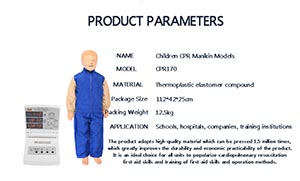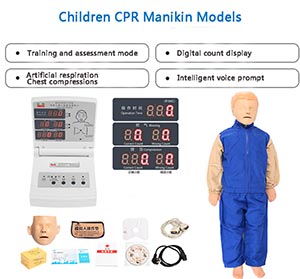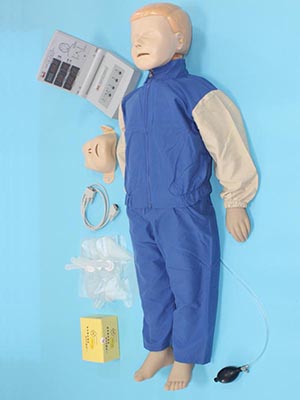15-01-2025
ADA MED SUPPLY LIMITED
Child first aid, especially child cardiopulmonary resuscitation (CPR), is a special and important area of emergency medicine. Compared with adult CPR, child first aid involves different physiological structures and operating skills, so emergency personnel must master specialized child first aid skills. As a highly simulated training tool, the Child CPR simulator can provide a real training experience for first responders to help them respond quickly and accurately when faced with children's first aid situations.
Advances in medical technology
Modern child cardiopulmonary resuscitation simulators use advanced medical technology to accurately reproduce the physiological characteristics and anatomical structures of children. These simulators are not only able to simulate the basic operations in adult CPR, such as chest compressions and rescue breathing, but can also be adapted to the unique needs of children. For example, child simulators are often designed to have airway and chest structures that are appropriate for the child's body type, reflecting details such as compression depth, frequency, airway patency, and so on. This simulation technology ensures that emergency personnel are able to perform efficient operations that meet the physiological needs of children during simulation training, helping them to become familiar with and master the skills to cope with different emergency situations.

Children's cardiopulmonary resuscitation simulator
Advantages of teaching model
Children's CPR simulators can not only help students master basic CPR skills, but also provide simulation training in a variety of complex situations. For example, these simulators can simulate children's emergency situations such as cardiac arrest and choking, and students can adjust their operations according to the feedback of the simulators during training. This simulation training has several advantages:
1. Real-time feedback: Simulators can give real-time feedback on the effect of the trainees' operation, help them correct the depth and frequency of chest compression, and ensure the standardization of compression and ventilation.
2. Situational diversity: Simulators can simulate various emergency situations in children's first aid, such as suffocation, traumatic bleeding, etc., to train students how to make correct first aid decisions in complex situations.
3. Risk-free environment: Repeated training in a simulated environment can not only reduce the risk in the practice process, but also greatly improve the proficiency of skills.

Data support
Studies have shown that first responders trained with child CPR simulators have significantly improved first aid skills and responsiveness. A study of medical students found that those trained in children's CPR simulators had about a 30% increase in their success in practice. In addition, after the simulation training, the decision-making time of students in the face of children's first aid is significantly shortened, which reduces the possible mistakes in first aid. For example, one experiment showed that participants trained as children's simulators were able to complete effective chest compressions in time and accurately perform airway management in the face of a child's cardiac arrest, increasing their success rate by more than 25%.
In addition, in the clinical data of the first aid training center, the accuracy and response speed of the operation in real first aid were significantly improved by the first aid team trained with a child CPR simulator. In a long-term study of CPR success rates in children, the training group improved success rates by about 20 percent compared to the group that did not receive the simulation training.

The prospect of professional training
Child cardiopulmonary resuscitation simulator is not only an important tool for first aid skills training, but also an important part of medical professional education and first aid training courses. Through this teaching model, medical students are able to practice repeatedly in a risk-free environment, solidify their first aid skills, and become more comfortable in real first aid situations. For first aid training students, simulators help them quickly master the key skills of child CPR, and continuously improve their emergency response ability through simulation training.
In clinical practice, children's cardiopulmonary resuscitation simulator has become one of the indispensable equipment in many hospitals and first aid training institutions. As technology continues to evolve, future child simulators will be more accurate and intelligent, providing a more comprehensive training experience for first responders.
conclusion
Through its advanced medical technology and highly simulated training model, the child CPR Simulator provides a valuable practical opportunity for first responders. Simulators not only help students master standard child first aid operations, but also improve students' emergency response ability and decision-making level under pressure by simulating a variety of complex first aid situations. Data-supported research shows that training with child simulators can significantly improve the success rate and response speed of emergency personnel and reduce errors in actual operations. Therefore, the child cardiopulmonary resuscitation simulator is undoubtedly an important tool to improve the child first aid skills of first aid personnel, and will play a more important role in the future first aid training.